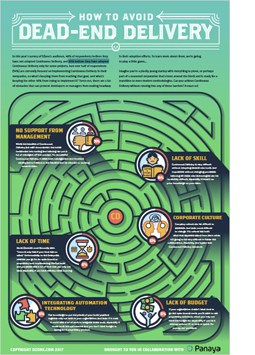Table of Content
In today’s digital economy, everyone wants to achieve faster release cycles by adopting agile and continuous delivery practices. However, a recent Forrester study stated that “agile at scale across teams, divisions, and enterprise is still relatively rare…and nearly 2/3 of businesses are still dissatisfied with release velocity.”
While, the survey results reflect the challenge organizations have implementing these methodologies, the question arises, where are the crux of organizations in their journey to agile. Where is the enterprise organization (end user companies) opposed to ISVs and vendor development?
Between the enterprise IT organization and the software vendor the gap in agile and continuous delivery grows further apart. Studies show that when focused on government and end user companies, only 24% are mostly using agile practices to a proficient level, as opposed to ISVs reaching about 40%. Why the par? What are these organizations challenged with when they want to implement continuous delivery?
As seen in the infographic below, How To Avoid Dead-End Delivery, lack of skill, time and corporate culture are some of the main challenges expressed by about 50% of all organizations surveyed. Additionally, lack of budget, automation and technology plague about 1/3 of organizations.

Frequent release cycles will require that organizations adopt an enterprise agile methodology. This in turn, demands that the entire organization, business and IT, start with a new mindset, one that understands that product roadmaps need to speak on both technical and business outcomes. And, to meet technical and business together you must start with collaboration and alignment and then add in automation. The three together work to ensure that within each release – scope, time and quality are met.
Collaboration
Large enterprises are accustomed to various teams working independently, the arch enemy to agile. In fact, inherent to corporate culture is the IT and Business divide. These two teams often have different goals as opposed to sharing the strategic corporate goal of driving the business forward. Additionally, each stakeholder of the product lifecycle has different domain expertise that support diverse delivery activities making collaboration a necessity to developing software faster.
SMEs, Business Analysts, QA professionals and developers often focus only on their part within the toolchain. To achieve greater results, they must work together from the start to ensure that each cycle is realistically and efficiently planned out. While Scrum teams have collaboration in check, many other parts of the organization have not achieved this collaborative style. Tools that foster collaboration via communication, visibility and internal policy and workflow will help remove the barriers between units and ultimately increase efficiency.
Delivery Toolchain Alignment
Organizations will need to align business, delivery and devops with tools and techniques that disseminate data access across the entire spectrum of activities. Today the delivery tool chain is very fragmented and data is held within different tools, teams and ironically, white boards in meeting rooms. Starting with Value Stream Management through to project and portfolio management and down to the level of requirement, development and testing activities, all stakeholders have relevant information to share and insights to derive to determine next steps. By congregating all data onto one platform business and IT can make smart timely decisions that are visible to the entire organization, making sure everyone is aligned to the strategic business goals put into place.
Automation
Automation is the key to an agile workflow, and manual processes cannot keep up with the pace of agile software development. To work faster, using the data that is amassed along the delivery cycle, organizations need a tool that goes beyond traditional automation. Here are just a few examples of processes that can be automated within the delivery chain to ensure efficiency: identifying change request entry points that are impacted by multiple requirements for a release cycle, pinpointing a system-wide bug that needs special handling, reassigning testing tasks to more available or dedicated teams, running a security scan on adapted code and identifying any vulnerabilities, analyzing performance in real time, and preparing optimized test plans. And there are many others.
Want to Avoid Dead End Delivery? Read practical tips you can implement into your organization in, Introducing Agility to Enterprise Applications

